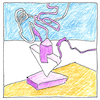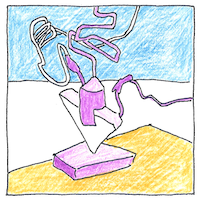William Shockley, Walter Houser Brattain, John Bardeen
electromagnetism

|
Transistor
Thermionic triode vacuum tubes rectified and amplified but burned out quickly. Bardeen, Brattain, and Shockley found that a semiconductor with three contacts could both rectify and amplify. Because it transfers a current across a resistor, their boss called it a transistor.
Ubiquitous
Ubiquitous, over sixty million transistors are made every year for each person on Earth. Transistor radios, quartz watches, displays, printers, digital cameras, pagers, cell phones, GPS receivers, music players, gaming consoles, computers, networks, appliances, vehicles, airplanes, weapons, medical devices, robots, and sensors include transistors and many of these devices would not be possible without them.
Surface states
A copper conductor carries a current mainly on its surface. The surface states of a semiconductor shield the material from penetration by an electric field. These are my analogies, like a solution in search of a problem. Therefore, I smile, wrinkle my forehead, and basically don’t much care whether everyone understands me. I’m not going to make it easy for anyone to get under my skin.



The first transistor was a point-contact, germanium crystal doped with “certain impurities.” Shockley, Brattain, and Bardeen were not the first to propose a solid-state transistor, and German physicists independently invented the same thing only months after. John R. Pierce, who supervised Bardeen, Brattain, and Shockley at Bell Labs, coined the term transistor in comparison to a property of the vacuum tube, transconductance.
In analog devices, transistors act as amplifiers. In digital electronic devices, transistors act as switches. The transistor can also act as a rectifier with a very low voltage drop.
See also in The book of science:
Readings in wikipedia: